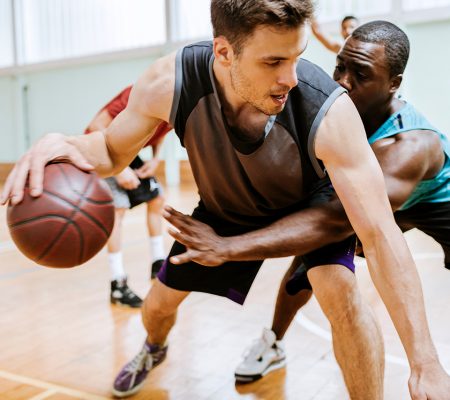Shoot Hoops Safely This Season: 6 Tips for Preventing Common Basketball Injuries
As the weather takes us inside, there’s one indoor sport everyone looks forward to: basketball!
Whether you love playing pickup games, helping your kid practice, or plan to join a local rec league, basketball is a blast! It’s a great way to fit in exercise and warm up those colder months. Even from the stands, basketball brings a lot of joy and excitement.
At the Orthopaedic Hospital of Wisconsin, basketball season also means an increase in sprains, strains, and other common basketball injuries. Should you (or your student-athlete) experience any of these unfortunate mishaps on the court, rest assured we’re here to help get you off the bench and back in the game. However, as we all know, injury prevention is always the best plan. Stay safe this season with these 6 tips for preventing common basketball injuries.
1. Wear the Right Shoes
It’s been said before, but it’s imperative—no matter what sport you pursue, the right shoes are absolutely vital for preventing injuries. Good news for sneaker collectors, high tops (like those classic Air Jordans) are made with ankle protection in mind. Look for non-slip shoes with plenty of ankle support.
Basketball incorporates a lot of dynamic (side-to-side) movement, which is a common cause of ankle injury. “Rolling” your ankle on the court can lead to a sprain, strain, and even a break, and many basketball injuries are to the lower half of the body. The right footwear ensures support and protection, even if you’re scrambling for an airball.
2. Gear Up with Protection
The right footwear is crucial but doesn’t skimp on other types of protection, either. If you’re a weekend warrior playing a pickup game or two, be sure to wear knee and ankle support if you’ve sustained a prior injury.
While basketball doesn’t come with all the pads and helmets that football does, it can still involve some contact. There’s always a chance you could get hit with the ball too. Be sure to wear a mouthguard and safety goggles, especially if you’re a contact lens user. Dress in loose, comfortable clothing that allows for movement and be sure to remove jewelry and other items that could get in the way.
3. Listen to Your Coach
One of the most significant ways to prevent common basketball injuries is to pay attention! Many injuries result from trips, missteps, and improper form. If you’re the parent of a basketball-playing student, encourage them to always listen to their coach’s advice and follow instructions.
Basketball rules are in place for protection. Many injuries occur because someone gets angry, too aggressive, or simply doesn’t pay attention. Getting hit with the ball, an elbow, or a total collision with another player can result in concussions, breaks, and other injuries. Keep your mind on the game and keep your head on a swivel—this is good for your game and your safety!
4. Warm Up and Stay Hydrated
No matter the sport, it’s essential to warm up properly and stay hydrated. Because basketball is often a highly engrossing sport, it’s easy for athletes to forget to grab a Gatorade on the sidelines (or sip some water in between plays). Hydration keeps you alert and better able to adapt to situations on the court.
Similarly, stretching and warming up is always a good idea before you engage in physical activity. Taking time to stretch will help you get in touch with your body, identify any areas that feel stiff or uncomfortable, and ensure you’re ready for action!
5. Check the Court for Safety
One way basketball players can protect themselves from common basketball injuries is to inspect the court before they play! If you’re playing a pickup game in the park or community lot, take time to look around for any potholes or divots on the court’s surface. Be sure you’re playing on a clean, safe surface whenever possible.
It’s also crucial that spills on the court are cleaned up quickly. Wet spots can present a significant slipping hazard. You may not think of broken wrists and strained shoulders as being common basketball injuries, but upper-body injuries can occur when an athlete catches themselves from a fall. (Finger jams are another common basketball injury to the upper body.) Play on a safe court and stay alert!
6. Pay Attention to Your Body
The other way athletes often sustain basketball-related injuries is by pushing themselves too hard and failing to listen to their bodies’ signals. There’s a common mentality to play through the pain, especially with team sports, when everyone cheers you on. But playing on an injured ACL or strained ankle can exacerbate the injury and make the situation much worse. It’s also important to note that almost 60% of injuries occur in the second half of the game when players are tired and pushing their limits.
While basketball injuries are often not as severe as in high-contact sports like football and hockey, knees, hips, and even back injuries can occur. If you notice something doesn’t “feel right,” hit the bench and take a time out. Should discomfort persist, it’s time to seek the assistance of a professional.
At the Orthpaedic Hospital of Wisconsin, we’re here to help! Don’t let an injury sideline you for the entire season. Make an appointment with our trained orthopedic specialists to assess the situation and figure out the right treatment course. Avoid common basketball injuries by taking the proper precautions before, during, and after the game.


